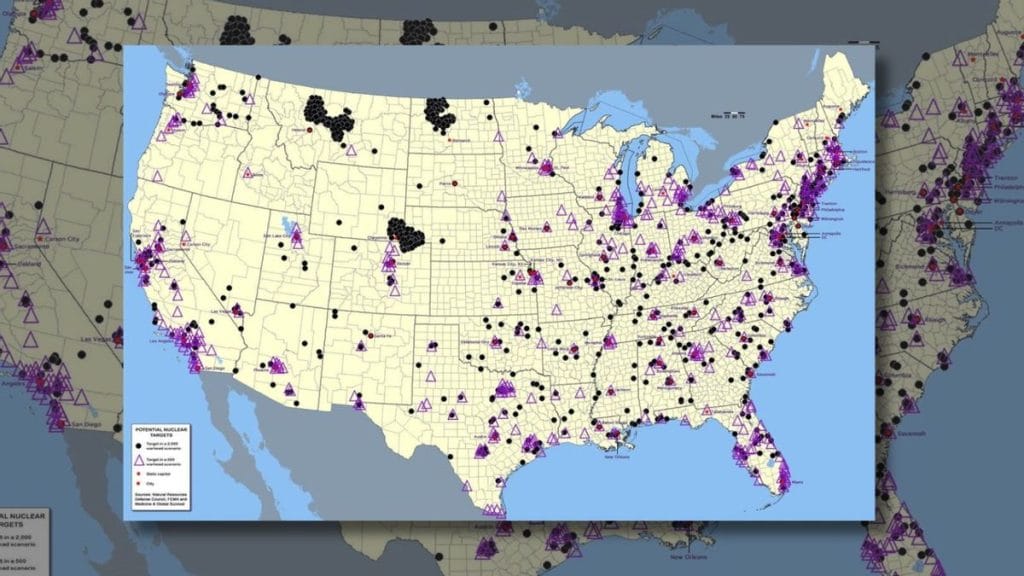
In June 2025, the U.S. Federal Emergency Management Agency (FEMA) released a map of potential nuclear targets in the U.S.
The map, created in 2002 by the nonprofit and nongovernmental organization Natural Resources Defense Council, was not created or release by FEMA, nor was it based on FEMA data. It was made to illustrate a paper examining hypothetical nuclear attacks from Russia and it was based on the authors’ hypotheses and calculations.
After the U.S. joined the conflict between Israel and Iran, striking three nuclear enrichment sites in Iran in June 2025, internet users shared what they claimed was a Federal Emergency Management Agency (FEMA) map showing potential nuclear targets in the U.S.
For example, the map appeared on TikTok (archived):

(@narutoisbttr0 is Tiktok)
As of this writing, the post had gained 203,500 likes and 52,400 reshares. The map appeared several times on TikTok, as well as on Threads and X.
Snopes found reports by news outlets, including The Mirror in 2025 and The Independent in 2023, that credited a 2015 CBS article for the map, asserting that it was based on data allegedly compiled by FEMA.
However, our investigation found that FEMA was not involved in the creation of the map, which did not date to either 2025 or 2015. Rather, as we’ll explain below, it first appeared in a 2002 paper about the potential effects of Russian nuclear attacks on health care services in the U.S. For this reason, we’ve rated the map miscaptioned.
The map appeared to have first circulated online on Sept. 20, 2011, on an internet forum for firearm enthusiasts named AR15.com. Other posts on Reddit and Pinterest between 2011 and 2014 said the map showed potential targets of Soviet nuclear missiles pointed at the U.S. during the C
Snopes found another 2023 report by the Daily Mail that included the map with a caption saying it was from 2002 and was the work of the Natural Resources Defense Council (NRDC), a nonprofit nongovernmental environmental advocacy group.
A black-and-white version of the map appeared in a February 2002 paper in a now-defunct journal known as Medicine and Global Survival. The paper, titled “Projected US Casualties and Destruction of US Medical Services From Attacks by Russian Nuclear Forces,” also credited the map to the NRDC. The paper presented two scenarios for potential Russian thermonuclear attacks on the U.S. and calculated how such attacks might affect the country’s medical infrastructure.
A spokesperson for the NRDC confirmed in an email that a staff member created the map specifically to illustrate this paper in 2002. It was based on the authors’ hypotheses and calculations they made using data from public databases, past NRDC research on nuclear weapons, and federal documents released to NRDC under the Freedom of Information Act. The data was first compiled and analyzed in a 2001 NRDC report, though the map did not appear in this earlier report.
An outline of the methodology for the map’s creation appears in the 2002 paper on pages 70, 71 and 72 (pages 3, 4 and 5 of the file):
The first scenario considers an attack on the continental United States involving 2,000 550-kiloton Russian warheads delivered to their targets by SS-18 and SS-19 intercontinental ballistic missiles (ICBMs). Each warhead is assumed to have a 25% chance of failing to explode on target because of technical problems, but the complex issues of warhead “fratricide” (the failure of a nuclear warhead to detonate due to the effects of nearby explosions) is not addressed, nor are the targeting logistics relating to “footprint size” (the maximum area within which targets could be reached by warheads independently targeted and released during the ballistic phase of the flight of a single ICBM).
[…]
The second scenario considers an attack on the continental United States by a Russian force of 500 550-kiloton warheads. The US is assumed to have deployed a missile defense system that can intercept incoming warheads. In response, the Russians have targeted their missiles on US population centers in order to maintain the ability to inflict unacceptable casualties. As with the first scenario, 25% of the 500 warheads are assumed to malfunction and a height of burst of 1,840 meters for all warheads is selected, resulting in no significant local fallout.
The 500 specific population targets for Russian nuclear weapons were selected as follows: a one square-kilometer population grid for the continental United States was computed using 1999 census data; for each one-square kilometer cell in that grid, the population within a 9.6 kilometer circle centered on the cell (i.e., the expected zone of mass fires, as discussed below) was summed; the cells were then rank-ordered according to the summed populations; and, finally, the 500 cells with the largest population sums were selected as targets under the constraint that the 9.6 kilometer circles around the selected cells did not overlap.
The authors then examined the effects of an NMD capable of intercepting 10%, 20%, or 30% of these warheads—an operational capability that greatly exceeds current expectations for this technology. Figure 1 displays the locations of the targets for both the 2,000 warhead and the 500 warhead scenarios.
In sum, the map was from 2002, and its creators made it for a paper that hypothesized two scenarios for a Russian nuclear attack, one with 2,000 warheads and the other with 500 warheads using data available in 2001 from public databases, past NRDC research on nuclear weapons, and federal documents released to NRDC under the Freedom of Information Act. FEMA did not create or release the map







